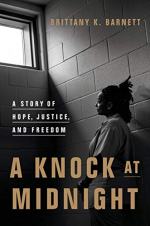|
This section contains 889 words (approx. 3 pages at 400 words per page) |

|
A Knock at Midnight Summary & Study Guide Description
A Knock at Midnight Summary & Study Guide includes comprehensive information and analysis to help you understand the book. This study guide contains the following sections:
This detailed literature summary also contains Topics for Discussion on A Knock at Midnight by Brittany K. Barnett.
The following version of this book was used to create this study guide: K. Barnett, Brittany. A Knock at Midnight. New York: Crown, 2020.
A Knock at Midnight describes the author’s story of life a clemency attorney, while also introducing the reader to her clients’ experiences within the criminal justice system. Brittany K. Barnett was raised in the small town of Fulbright, Texas. She was close with her extended family, especially her mother and her sister, Jazz. However, when Brittany was ten, her mother began using crack cocaine. Her mother's addiction tore the family apart, and Brittany moved in with her grandparents in the nearby town of Commerce to attend high school. Although Brittany excelled in school, she also struggled to escape an abusive relationship with her boyfriend, Red. She broke off the relationship and began attending college at the University of Texas at Arlington while working nights at Chase Bank.
In 2006, Brittany's mother was incarcerated for violating her probation after she was charged with possession of crack cocaine. Brittany and Jazz visited her weekly in prison. In the meantime, Brittany graduated, began working as an accountant, and then decided to pursue her dream of becoming an attorney. In her first semester of law school, her mother was released from prison.
The summer after her first year of law school, Brittany interned at a Texas courthouse and saw discrepancies and injustices in criminal punishments there. She also took a course in Critical Race Theory that further exposed racism in the justice system. The father of her childhood friend, Keyon Mitchell, contacted her for legal help. Keyon had received a life sentence in prison for drug dealing while in college. Brittany believed this was unjust. Working with a lawyer, she filed a motion and was able to have Keyon's sentence reduced from life to 32 years based on new federal guidelines.
While researching for her Critical Race Theory course, Brittany discovered the story of Sharanda Jones. Sharanda was a single mother in Texas who had received a life sentence without the possibility of parole for a first-time drug offense. Brittany began corresponding with Sharanda and became determined to help her get out of prison. After graduating from law school, Brittany began working at a firm and took on Sharanda as a pro bono client, along with Mike Wilson, the friend of one of Brittany’s family friends. Mike had also received a life sentence in prison for drug dealing twenty years ago and was still incarcerated even though he’d had a stroke and couldn’t get adequate medical care.
Over the following years, Sharanda’s quadriplegic mother Genice, who had also received a life sentence for drug charges, passed away due to the lack of medical care she received while in prison. Meanwhile, Brittany continued to advocate for her clients and founded a nonprofit organization called G.E.M. (Girls Embracing Mothers), which organized meetings and workshops between incarcerated women and their daughters. Brittany also explored the option of presidential clemency for her clients, realizing that they could not find relief through the legal system. She filed clemency petitions for Sharanda and Donel Clark, a man given a 35-year sentence in Texas for drug dealing.
In 2014, Donel’s clemency petition was granted. The same year, Brittany was able to free Mike by filing a motion based on a discrepancy in the amount of drugs Mike had been convicted for selling. He and his sons were able to have a joyous reunion. Meanwhile, Brittany advocated for Sharanda by publishing her story in an ACLU report, giving speeches, and creating petitions. In 2015, Sharanda’s story was published in a well-read article in ‘The Washington Post.’ Finally, around Christmas of 2015, Obama granted Sharanda’s clemency petition.
Brittany took on another client, Corey Jacobs, a formerly successful music producer who had been given sixteen consecutive life sentences for dealing drugs while in college. She filed another clemency petition which included a letter from Corey’s sentencing judge, stating that he regretted the sentence he imposed. In 2016, Brittany left her corporate job and started working full-time as the leader of the #ClemencyNOW petition, which aimed to put pressure on President Obama to grant more clemencies before his term ended. She also took on even more clients and led a team of law students to work on their own clemency petitions. Near the end of Obama’s term, Corey received clemency.
After Obama’s term ended, Brittany took on another client, Chris Young. He was a mathematical genius who had grown up in poverty and experienced multiple traumatic events. A judge sentenced him to life in prison for drug dealing, but resigned over the sentence because he felt it was unjust yet he was forced to impose it. Brittany continued to advocate for clemency and criminal justice reform, particularly for those serving time under federal drug laws. Along with Sharanda and Corey, she founded the Buried Alive Project, an organization dedicated to criminal justice reform.
The book concludes with Brittany attending a brisket dinner with Sharanda, Mike, Mike's brother Wayland, and Donel, while taking a call from Corey, who was working for the rapper Sean “Diddy” Combs. She received a box of books from Chris, who was being transferred to a different facility, and imagined what he could achieve if he was not incarcerated.
Read more from the Study Guide
|
This section contains 889 words (approx. 3 pages at 400 words per page) |

|



